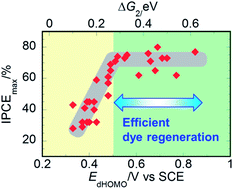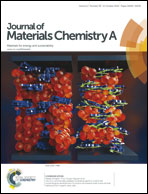Systematic evaluation of HOMO energy levels for efficient dye regeneration in dye-sensitized solar cells†
Abstract
Thirty ruthenium complexes of the types [Ru(tctpy)(C^N)NCS] and [Ru(tctpy)(N^O)NCS] (C^N = cyclometalating ligand and N^O = pyridinecarboxylate and its derivatives) were synthesized and evaluated to identify the highest occupied molecular orbital (HOMO) energy level (EHOMO) for efficient dye regeneration in dye-sensitized solar cells. EHOMO of these complexes was systematically tuned by changing the electron-donating ability of the C^N and N^O ligands. For complexes with an EHOMO in the potential range more negative than 0.5 V vs. a saturated calomel electrode (SCE), the incident photon-to-current conversion efficiency (IPCE) increased with a positive shift in EHOMO but could not exceed 70%, suggesting that rapid dye regeneration is difficult. On the other hand, high IPCEs above 70% were often observed for complexes with an EHOMO more positive than 0.5 V vs. SCE. It is thus concluded that there is a threshold for efficient electron transfer near 0.5 V vs. SCE (ΔG2 ≈ 0.3 eV) for the series of these sensitizers.


 Please wait while we load your content...
Please wait while we load your content...